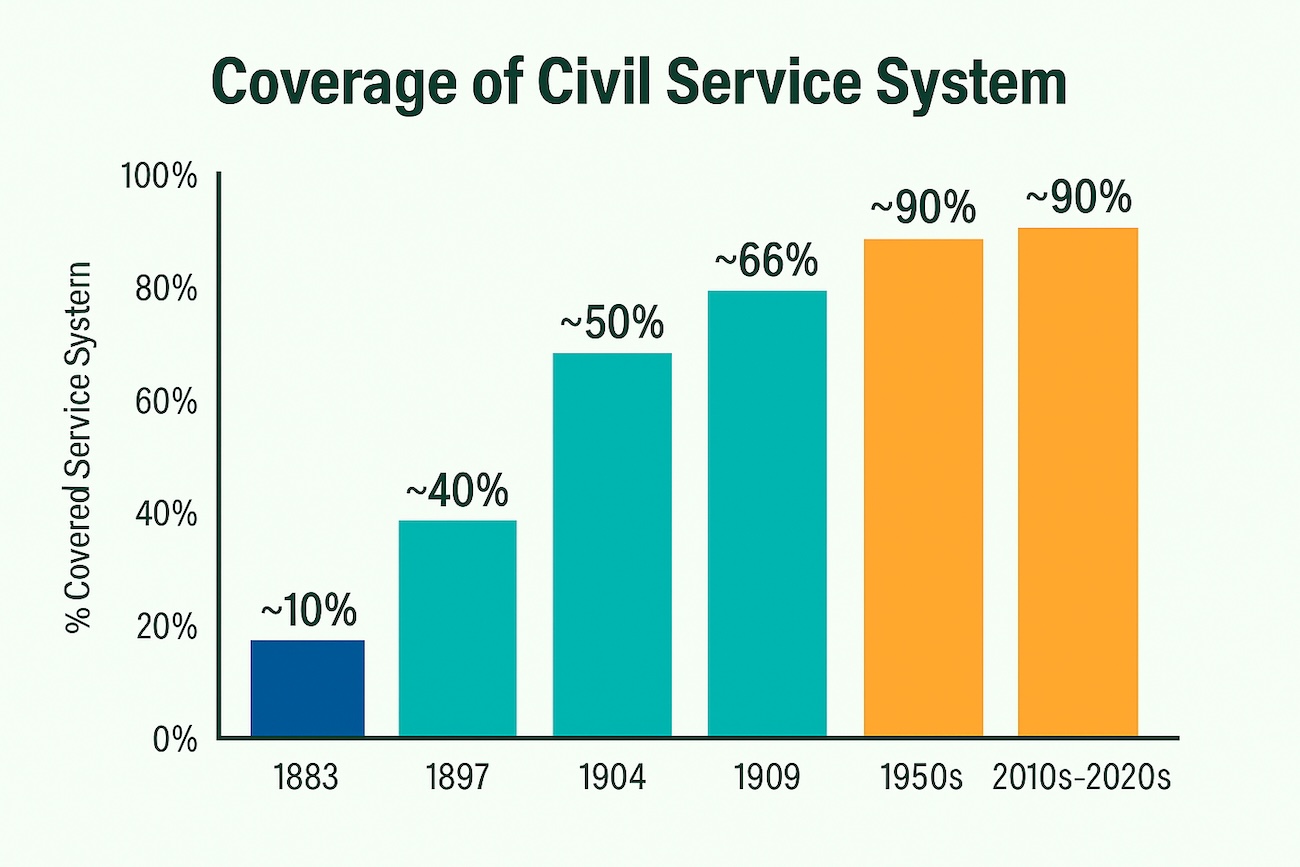
Illustration by OpenAI
A time machine tour of civil service reform
COMMENTARY | From Washington to Trump, every era has redefined the rules of federal employment. If you could set the clock, which version of the merit system would you choose?
In 1895, science fiction writer H.G. Wells introduced the world to the concept of time travel. Pick a time, he told his dinner guests in The Time Machine, and manipulate a lever in his machine: “this lever, being pressed over, sends the machine gliding into the future, and this other reverses the motion.”
That’s the stage we’ve set with the current debate on the merit system. The real debate between the Trump administration reformers and others in the battle is where they want to set the lever for merit system principles. If truth be told, no one—right, left, center—likes the current merit system.
So, if we know what we don’t like, where should we set our time machine setting? Here are some settings.
- George Washington and the “fitness test” (1789). Washington insisted that employees of the new government must have great capability and a strong reputation for honesty. He also considered an ideological screen: were applicants supporters of the colonies before the Revolution. And, in addition, being a Federalist helped. He gave preference to former officers, but not enlisted men, in the Revolutionary Army.
- Andrew Jackson and the “spoils system” (1829). After Jackson’s election, job-seekers descended on Washington like a plague of locusts. Jackson was convinced that the officials already in the federal government were a deep-rooted special interest more intent on keeping their jobs and power than doing what the president wanted. Loyalty to the president was more important than a candidate’s professional qualifications. Applicants sometimes paid a year’s salary to buy a four-year job.
- The Pendleton Act and the creation of the civil service system (1883). After the assassination of President James Garfield in 1881 (it is obligatory in all accounts to refer to the shooter, Charles J. Guiteau as a “disappointed office seeker”), a bipartisan movement arose to create genuine reform. Sen. George H. Pendleton, D-Ohio, introduced a bill on civil service reform, and he got support from President Chester A. Arthur, R-N.Y. The Pendleton Act established that federal employees would be hired on the basis of merit. It also created the Civil Service Commission to manage the new system. The act covered about 10% of all federal employees. Beyond protection from being fired for political reasons, the Pendleton Act had no basic protections for federal employees, especially on removals. That was up to the president to decide.
- Passage of the Lloyd-LaFollette Act and related presidential action (1912). Established protection to federal employees against dismissal except for cause and defines the procedures that supervisors must follow in doing so. Federal employees gained the right to join unions and they could not be fired for doing so, although they could not strike. The coverage of the civil service system expanded to about two-thirds of all federal employees.
- World War I-era (1944-1949). Veterans preference was established, with vets receiving a points bonus in ranking applicants. Retirement provisions were improved. The Classification Act of 1949 created a much more simplified collection of grades and salaries; the GS system we know today, with standardized job titles and grades across the federal government, came from this act. By 1950, about 80% of all federal employees were covered by the merit system.
- The Civil Service Reform Act and related presidential actions (1978). Moved civil rights protections to the Equal Employment Opportunity Commission. Abolished the Civil Service Commission and created the Office of Personnel Management, with authority over the examination, appointment, compensation, training, awards, and benefits for federal employees. Created the Merit Systems Protection Board to decide appeals from federal employees about possible abuses of merit system protections, and the Office of Special Counsel to deal with whistleblower cases. Established the Federal Labor Relations Authority, which took over labor relations issues that the Civil Service Commission previously had managed. Established merit system principles as well as prohibited personnel policies, which defined the basic principles that all federal personnel practices would have to meet. Created the Senior Executive Service, which took in what had been GS-16, GS-17, and GS-18 positions. Repealed the previous performance rating system and replaced it with mandatory performance management systems, created by each agency, which in turn would be used for employee rewards and decisions to demote or remove poor performing employees. Intended to make it easier to remove poor performers.
- Trump administration plan (2025). The civil service is full of “deep state” denizens, devoted to keeping their jobs and undermining Trump’s policies. The most important thing is to remove as many civil service employees as possible, both by firing probationary employees and by firing or laying off very large numbers of civil service members. The administration created a new Schedule Policy/Career (or Policy P/C, for short) for 50,000 or more federal employees with a role related to policymaking or policy advice, who could be fired at will. Replacements, if any, would be hired through the merit system. Thus, the merit system would be used for firing, but its protections would not apply to dismissals. There is a proposal that, to keep civil service protections, new employees would have to pay 50% more of their income for retirement benefits. In that plan, any employee wishing to challenge an adverse personnel action would have to pay a $350 fee to file their case.
- Reformers’ dream package (2035). Some reform-minded people would provide veterans’ preference but use it only for the initial hiring of new employees, which would be made without an tool for political favoritism. They would extend the probationary period for new employees, protect existing employees from at-will firings but make it much easier to dismiss poor performers, improve the performance management of federal managers by linking their results with their salaries, but prevent firing for failure to be in sync with a current administration’s policies. Most of all, they would orient the system much for the federal government’s talent needs for the future by forcing federal agencies to match their missions with the skills that they need and by focusing the federal government’s screening process on recruiting and finding those new employees.
And, to help you set your time machine lever, here’s a chart of how the percentage of federal employees covered by the federal civil service has changed over time.

Some friends of mine have said they would set it at 1911, just before the passage of the Lloyd-LaFollette Act, at a time when merit determined the hiring of federal employees but when presidents had much more power to dismiss employees. Others have said 1945, before the GS classification system emerged. One experienced expert told me it would be 1977, before the 1978 reforms that, in the expert’s opinion, introduced the pathologies that make human resources managers so unhappy today. And, of course, some of my conservative friends would choose the current Trump action.
Where would you set your time machine?







